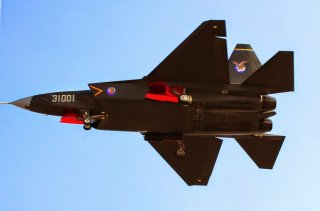China's J-31 Stealth Fighter vs. America's Mighty F-35: Who Wins?
It is widely believed that the J-31 is modeled in part off of stolen F-35 technology.
Here's What You Need to Remember: Experts predict that the J-31 will make rapid inroads in the international market in the future, and will undoubtedly steal the limelight from the F-35.
Several years ago, the president of a leading Chinese defense company boasted that China’s J-31 stealth fighter jet could definitely take down the F-35 Joint Strike Fighter.
Appearing on China’s state broadcaster on in 2014, Lin Zuoming, president of Aviation Industry Corp of China (Avic), the state-owned Chinese defense company that manufactures the J-31, boldly declared that “When it [the J-31] takes to the sky, it could definitely take down the F-35. It's a certainty.”
It is widely believed that the J-31 is modeled in part off of stolen F-35 technology.
Lin went on to say that the J-31 would compete with the F-35 in the global marketplace, painting China’s second stealth fighter as a low-cost alternative to the U.S. made fifth-generation jet.
"The next-generation air forces that are unable to buy the F-35 have no way to build themselves up. We don't believe the situation should be that way," Lin said, Reuters reported. He added, “The world should be balanced. Good things shouldn't all be pushed to one party."
The J-31, which is alternatively referred to as the Falcon Hawk, Falcon Eagle, Shenyang FC-31, and F-60/J-21, is a twin-engine (Russian RD-93s) jet that conducted its first flight sometime in 2012. The jet did not make its first public appearance until the Zhuhai Air Show in China last month. At the show, the jet made a demonstration flight but was not put on display at the air show, however.
Long before the Zhuhai Air Show, Chinese officials began comparing the J-31 to the F-35, and suggesting it could compete with the Joint Strike Fighter in international markets. In August 2013, for example, the People’s Daily, the official newspaper of the Chinese Communist Party, carried an article that postulated that the J-31 “represents a serious threat to U.S. arms manufacturers.” It went on to say, “Experts predict that the J-31 will make rapid inroads in the international market in the future, and will undoubtedly steal the limelight from the F-35.”
As to the J-31’s ability to take down American and allied F-35s, most experts agree it’s too early to tell, although the J-31 received largely negative reviews at the air show last month. For instance, a senior U.S. pilot told USNI News at the time that, once operational, the J-31 could probably challenge America’s fourth generation unstealthy American fighters.
“They’ll probably be a handful right off the bat for all of our fourth gen stuff,” the pilot was quoted as saying.
On the other hand, the same pilot added, “I think they’ll eventually be on par with our fifth gen jets — as they should be, because industrial espionage is alive and well.”
Similarly, frequent TNI contributor Robert Farley said, “Will Chinese fighters be as ‘stealthy’ as Western fighters? We won’t know that for another five or 10 years.”
Zachary Keck is the Wohlstetter Public Affairs Fellow at the Nonproliferation Policy Education Center. Before that, he was a researcher at the Belfer Center for Science and International Affairs. Previously, he was the managing editor of The National Interest. Keck has also been the managing editor of The Diplomat. You can find him on Twitter: @ZacharyKeck.
This article first appeared several years ago and is being republished due to reader interest.
Image: Reuters

